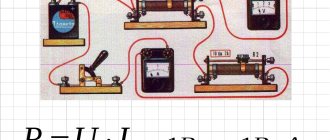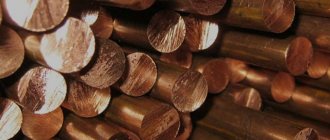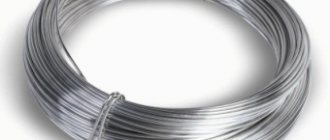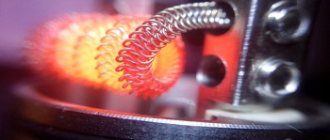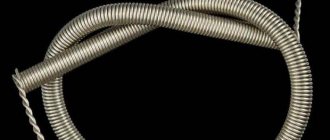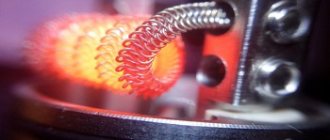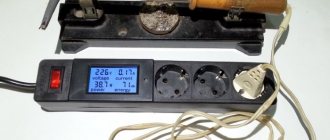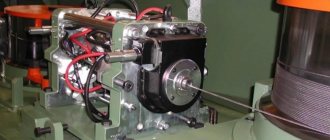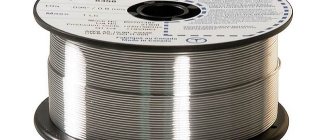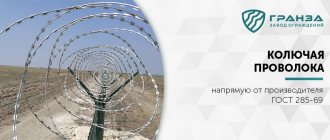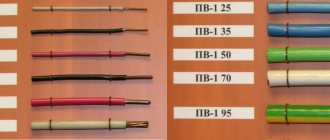Calculation of wire length for a spiral
Required heater power W
Supply voltage V
Choose material
Select the wire diameter from standard industrial sizes.
mm
The results obtained do not take into account the increase in the electrical resistance of the conductor with increasing temperature. Therefore, the actual power (as well as the current consumption from the network) is always slightly lower than the calculated values.
Calculation of weight and length
Recalculate
Product Type
Alloy
Diameter, mm.
Length, m.
Calculate
Nichrome and fechral are the most common materials for creating a resistive heater. Nichrome (specifically Nichrome 80) is made from a mixture of nickel and chromium. Fechral or otherwise known as Kanthal is an iron-chromium-aluminum (FeCrAl) alloy.
Basic information and brands of nichrome
Nichrome is an alloy of nickel and chromium with additions of manganese, silicon, iron, and aluminum. The parameters of this material depend on the specific ratio of substances in the alloy, but on average they lie within the limits:
- specific electrical resistance - 1.05-1.4 Ohm*mm 2 /m (depending on the brand of alloy);
- temperature coefficient of resistance - (0.1-0.25)·10 −3 K −1;
- operating temperature - 1100 °C;
- melting point - 1400°C;
In tables, resistivity is often given in µOhm*m (or 10 -6 Ohm*m) - the numerical values are the same, the difference is in dimension.
Currently, there are two most common brands of nichrome wire:
- Х20Н80. It consists of 74% nickel and 23% chromium, as well as 1% each of iron, silicon and manganese. Conductors of this brand can be used at temperatures up to 1250 ᵒ C, the melting point is 1400 ᵒ C. It is also characterized by increased electrical resistance. The alloy is used for the manufacture of elements of heating devices. Specific resistance – 1.03-1.18 µOhm m;
- Х15Н60. Composition: 60% nickel, 25% iron, 15% chromium. Operating temperature is no more than 1150 ᵒ C. Melting point – 1390 ᵒ C. Contains more iron, which increases the magnetic properties of the alloy and increases its anti-corrosion resistance.
You will learn more about the grades and properties of these alloys from GOST 10994-74, GOST 8803-89, GOST 12766.1-90 and others.
As already mentioned, nichrome wire is used everywhere where heating elements are needed. High resistivity and melting point make it possible to use nichrome as a base for various heating elements, from a kettle or hair dryer to a muffle furnace.
Tungsten wire and its features
Basic properties of tungsten
Tungsten is a refractory metal that is used in the manufacture of heat-resistant alloys. It has a high density, its density reaches 19.3 g/cm3. Tungsten begins to melt at 3395°C and boils at 5500°C, while its evaporation rate is low. As for the electrical conductivity of this metal, it is approximately 1/3 of the value of the same parameter for copper. Tungsten is brittle at low temperatures and also has low oxidation resistance. This metal can be processed by pre-heating it. Externally, tungsten is similar to steel.
Tungsten wire production
The most popular long products made from tungsten are wire. It is produced in accordance with GOST 25501-82. Tungsten wire is a semi-finished product, the cross-section of which remains constant along its entire length. It is made by pressing or drawing.
Since tungsten has low technological plasticity, to increase this property it is heated, which in no way affects the strength of the material, which still remains high. Only after such procedures can wire be obtained by any method of processing under pressure. Supplied in coils or coils.
Powder metallurgy methods are often used to produce tungsten blanks, which makes it possible to improve some of the quality and properties of tungsten. A shtabik is a semi-finished product from which wire is made. It is first heated, and then a special rotary forging machine is used to carry out the forging. This is how tungsten rods are obtained, the diameter of which is 2-3 mm. Wire is obtained from them by drawing in a heated state. The diameter of the resulting long rolled metal is represented by a number of standard values up to 0.3 mm.
Scope of application of tungsten wire
The electrical and electronics industries are the main consumers of pure tungsten. The metal is indispensable in cases where low vapor pressure is required at operating temperatures up to 2500 °C. Tungsten wire is a material for heating elements of furnaces operating in a hydrogen, neutral or vacuum environment, heating up to 3000 °C. Thermocouples are made from this grade of metal. For their manufacture, tungsten-rhenium wire with a rhenium content of 5 and 20% (VR 5/20, VR5/20, VR5/VR20) is used.
More information about the use of tungsten wire grades VA, VM, VRN, VT-7, VT-10, VT-15 can be found by reading GOST 18903-73.
Calculation methods
By resistance
Let's figure out how to calculate the length of nichrome wire based on power and resistance. The calculation begins with determining the required power. Let's imagine that we need a nichrome thread for a small soldering iron with a power of 10 W, which will operate from a 12V power supply. For this we have wire with a diameter of 0.12 mm.
The simplest calculation of the length of nichrome by power without taking into account heating is performed as follows:
Let's determine the current strength:
We calculate the resistance of nichrome wire according to Ohm's law:
The length of the wire is:
where S is the cross-sectional area, ρ is the resistivity.
Or using this formula:
But first you need to calculate the resistivity for nichrome wire with a diameter of 0.12 mm. It depends on the diameter - the larger it is, the less resistance.
The same can be taken from GOST 12766.1-90 table. 8, where the value of 95.6 Ohm/m is indicated, if you recalculate it, you get almost the same thing:
For a 10 watt heater powered by 12V, you need 15.1cm.
If you need to calculate the number of turns of a spiral to make it from nichrome wire of this length, then use the following formulas:
Length of one turn:
where L and d are the length and diameter of the wire, D is the diameter of the rod on which the spiral will be wound.
Let's say we wind nichrome wire on a rod with a diameter of 3 mm, then we carry out the calculations in millimeters:
But at the same time, it is necessary to take into account whether nichrome of such a cross-section is even capable of withstanding this current. Detailed tables for determining the maximum permissible current at a certain temperature for specific sections are given below. In simple words, you determine how many degrees the wire should heat up to and select its cross-section for the calculated current.
Also note that if the heater is located inside a liquid, then the current can be increased by 1.2-1.5 times, and if in a confined space, then vice versa, it can be reduced.
By temperature
The problem with the above calculation is that we calculate the resistance of the cold spiral by the diameter of the nichrome thread and its length. But it depends on the temperature, and you also need to take into account under what conditions it will be possible to achieve it. While such a calculation is still applicable for cutting foam plastic or for a heater, it will be too rough for a muffle furnace.
Let us give an example of calculations of nichrome for a furnace.
First, determine its volume, say 50 liters, then determine the power, for this there is a rule of thumb:
- up to 50 liters – 100 W/l;
- 100-500 liters – 50-70 W/l.
Temperature coefficient of resistance
The current resistance, expressed in ohms, for a particular alloy depends on the temperature of the alloy. This deviation is indicated as a percentage of the actual room temperature resistance. Generally, resistance increases as temperature increases, so a wire heating element has a resistance of 1 ohm at room temperature (20°C or 68°F), can reach a resistance of up to 1.08 ohm at 650°C or 1202°F, hence resistance increases by 8% due to heating.
What is better to make a heater for an electric muffle furnace from - comparison of fechral and nichrome
The most significant part of an electrothermal installation is the heating element. The main component of indirect heating devices is a resistor with high resistivity. And one of the priority materials is chromium-nickel alloy. Since the resistance of nichrome wire is high, this material takes a leading place as a raw material for various types of electrothermal installations. Calculation of a heater made of nichrome wire is carried out in order to determine the size of the heating element.
Heaters for muffle furnaces: requirements for manufacturing materials
If you are in doubt whether fechral or nichrome is better as a base for a muffle furnace heater, consider their characteristics. Each of them has different indicators:
- Electrical resistance . The higher it is, the better. Alloys with high electrical resistance heat up faster. They can be used in smaller quantities than other raw materials. It is very comfortable. In this case, it becomes possible to install a heater made of nichrome wire inside the structure. You don't need a lot of space for this.
- Constancy of physical properties . It is very difficult to work with dynamic elements such as non-metals. It is necessary to resort to the use of additional transformers. This can complicate the operation of an industrial drying oven or muffle furnace.
- Temperature coefficient . When the temperature level changes, the electrical resistance of the element also becomes different. The nichrome heater changes its performance minimally.
- Heat resistance . The limit level differs for different materials. After studying the technical characteristics, you will see how resistant nichrome or fechral is to high temperatures.
An industrial drying cabinet must have a very high-quality design, including a reliable heating element
How to wind an electronic cigarette
Before you start servicing your electronic cigarette, you should first determine what resistance value will be optimal for working with your power source. If your box mod has high power (100 watts or more), then just focus on a resistance of 0.2 Ohm to 0.5 Ohm. Of course, for high-quality operation of an electronic cigarette, you will need a power source that can provide the required amount of power, which is enough to work with the resistance of the manufactured coil. Therefore, you need to know the technical characteristics of the power supply of your vape device.
You will need tools such as:
The maintenance process for almost any evaporation system should be divided into several stages, in each of which it will be necessary to perform certain manipulations to install and correct the heating element and wick. Professionals have different approaches to winding, but we will consider a universal way to produce high-quality work. Don’t forget, for a positive result you need to have skill and if it doesn’t work out the first time, then don’t despair and try again.
Some notes
You can improve the device using additional parts:
- gypsum
- steel wire
- switch
The steel bracket does not have to be adapted in any way inside the case - it is only needed as a convenient stand for the device. The switch allows you to easily operate the device. It can be installed on the side of the jar body by adding a couple of screws. But gypsum will help give strength and durability to the nichrome wire. Pour the dry gypsum into water, dilute it and dip a twisted spiral into the solution, then air-dry it under a layer of gypsum until it hardens. Now the heating will be softer, and the device will be more durable and safe. The main thing is not to forget to leave contacts at the ends for connecting the wires.
Result: We have a simple and effective device for heating a room. If everything is done correctly, it will be safe to use and will consume very little power.
A simple homemade panel heater: assembly diagram, photo of production.
With the onset of cold weather, the topic of heating residential premises becomes relevant, and many are wondering how to additionally heat a living room, work space, cottage or garage using a heater. In this article we will look at how to make a simple, cheap and at the same time safe electric heater.
Let's summarize how to profitably sell tungsten
In order to get as much profit as possible from the delivery of tungsten scrap, you need to prepare the goods for delivery in advance.
The highest price can be obtained if:
- clean the raw materials (make sure that there are no other metals, earth or dirt in it);
- sort recyclables by type and material;
- compress the product using any suitable press;
- collect as much metal as possible, because in most companies the fundamental factor in increasing the price is the amount of scrap delivered;
- consider at least five large companies involved in scrap collection and choose the most favorable price.
Thus, by donating tungsten, you not only receive significant benefits, but also help the industry, which is experiencing a shortage of this rare but necessary metal.
Differences between fechral and chrome: what to choose as a heater base
Nichrome and fechral heaters are the best for muffle electric furnaces. But they also have some differences between themselves
Features of nichrome
Among the advantages of the material:
- Preservation of mechanical properties when heated.
- Creep resistance.
- Easy to melt and weld.
- Ease of processing.
- No aging processes.
This alloy also has some disadvantages, including:
- The high cost of manufacturing nichrome heaters is due to the high cost of nickel.
- Ability to operate at lower temperatures compared to fechral elements.
To ensure that the furnace gives the desired result in processing materials, do not forget to first calculate the nichrome wire for the heater.
Features of fehrali
The multicomponent composition has such positive characteristics as:
- Low alloy price.
- High level of heat resistance.
Some heaters for fechral muffle furnaces are capable of operating even at temperatures of 1400 degrees. It is important that their diameter is at least 6 millimeters
The disadvantages include:
- Fragility at temperatures above 1000 degrees.
- Magnetic due to the presence of iron.
- Elongation of the base during operation.
- Low level of creep resistance.
Stage 3
When the coils are installed, they need to be burned out. If you are using kanthal wire, you can safely burn the spiral red-hot by pressing the heaters with ceramic tongs so that the turns are pressed tightly against each other. Kanthal burning should be carried out at a voltage of 3 to 3.5 Volts.
After burning, the total winding resistance may change slightly, usually within the range of plus or minus 0.3 Ohm.
And so, only spirals made of kanthal and steel should be burned. Nickel (Ni) and titanium (Ti) do not need to be burned; it is enough to make a neat spiral with a small distance between the turns. But Ni and Ti are in less and less demand, since steel coils are much more versatile and can operate not only in temperature control mode, but also in wattage mode.
Progress
First, we separate the cooler grille from the fan, it will also be useful to us. We place the fan with the correct side (so that it blows outward) into the jar, and secure it to the bottom with several screws. It will be needed to drive hot air into the room from the hot wire. Now we roll the wire itself into a spiral - it can be wound on a thick pencil and removed. This is necessary for greater heat transfer when air passes past the spiral. We fix the spiral inside the case, the ends need to be brought out and connected to the wires. Our heating is almost ready. All that remains is to cover the case with the cooler grill for safety. It’s as if it was specially created for this - it turned out to be an excellent device, reminiscent of a hot hair dryer.
Scope of application of heaters made of nichrome and fechral
The nichrome heater is most often used in the design of firing and drying equipment. It can often be found in the base of water heaters and electric stoves. Laboratory drying cabinets with nichrome heaters are considered high-performance.
Laboratory low-temperature furnace is equipment for the most precise heat treatment
Fechral plates and wires are in demand in the development of systems operating at temperatures up to 1400 degrees. They are actively used in the field of high-alumina ceramics.
Calculation of the resistance of a nichrome spiral and its length
Having decided on the power, we proceed to calculate the required resistance.
If the determining parameter is power, then first we find the required current using the formula I=P/U.
Having the current strength, we determine the required resistance. To do this, we use Ohm's law: R=U/I.
The notations here are generally accepted:
- P – allocated power;
- U is the voltage at the ends of the spiral;
- R – spiral resistance;
- I – current strength.
Now let's determine the length we need. It depends on the resistivity and wire diameter.
You can make a calculation based on the resistivity of nichrome: L=(Rπd 2 )/4ρ.
- L – required length;
- R – wire resistance;
- d – wire diameter;
- ρ – resistivity of nichrome;
- π – constant 3.14.
But it’s easier to take ready-made linear resistance from the tables of GOST 12766.1-90. You can also take temperature corrections there if you need to take into account changes in resistance when heated.
In this case, the calculation will look like this: L=R/ρld, where ρld is the resistance of one meter of wire having a diameter d.
Where can I get nichrome wire?
There are several options for how and where you can purchase a nichrome product.
Today, in almost every locality there is a help desk for goods and services. By contacting it, you can obtain information from the operator about which organization sells nichrome and its contact numbers. This information can also be found on the Internet. However, in this situation, the chances of purchasing a normal product are almost zero.
, because if anyone undertakes to deliver the material, it will only be one and a half to two meters. Organizations mainly specialize in wholesale sales. But it’s still worth clarifying.
If such a product is sold in another city, then you can use it. However, this option requires an additional payment.
for shipping. You can purchase wire in specialized stores. These could be “Radio Components”, “Skillful Hands” and other similar pavilions. The sellers of such private stores, who sell various spare parts, know each other very well. Therefore, if such a “private trader” does not have nichrome wire in stock, he can tell you where to purchase it. By the way, you can find it in an ordinary hardware store. Spirals for electric stoves are made of nichrome.
Not a single locality can do without a bazaar where you can buy anything. The most important thing is to carefully go around the entire market and you can even ask the sellers. You may also come across such a product made of nichrome.
find an old device somewhere
, for example, a laboratory rheostat. In itself it is of no value, but it has a small amount of nichrome wound on it.
Nichrome wire is a high-quality plastic product due to its remarkable technical characteristics. Buying or getting it in any other way, although difficult, is possible. You just need to take the initiative and try all the above methods.
For this you will need nichrome wire. The resistivity of nichrome wire grade X20N80 is given in the table. For shaped cutting, a thermal cutter made from a piece of nichrome wire is used.
Nichrome wire X20H80 is used to make a spiral when independently rewinding the atomizer. Therefore, to obtain the same value, in the case of thin nichrome wire, fewer turns will need to be made. However, for use at higher power, it is recommended to use thicker nichrome wire or 2 thin threads braided.
Nichrome wire is used for the manufacture of cutters, jigsaws, soldering irons, machines for cutting foam plastic, polystyrene, etc. Wire is obtained from them by drawing. Nichrome products are used in places that require high-quality metal. The ends of the nichrome wire are attached to springs mounted on M4 screws. The screws themselves are screwed into metal posts pressed into the base of the machine.
Before screwing the screw into the rack, a groove was machined at its head so that the nichrome wire could not move arbitrarily during adjustment, but would occupy the required position. To prevent nichrome wire from sagging due to elongation when heated, it is secured to the screws through springs. After preparing all the fasteners, you can fasten the nichrome wire. Nichrome wire is not much different in appearance from steel wire, but it is made from an alloy of chromium and nickel.
However, unlike steel or copper wire, nichrome wire has a higher resistivity and can withstand heating temperatures up to 1200˚C while maintaining high mechanical strength.
It should be noted that for heating the nichrome wire of a foam cutting machine, a power source of both alternating current and direct current is suitable. Remove the plug from the network and connect the wires coming from the nichrome thread to the “Load” terminals. Insert the power cord plug into the socket and use the phase indicator to check the absence of phase on the nichrome wire. Having dealt with the phase, you can slowly turn the LATR handle to apply voltage to the nichrome wire.
In this circuit, thanks to the isolating step-down transformer, the nichrome spiral is not galvanically connected to the electrical network and is therefore safe for operation. After all, when cutting foam plastic on a device, there is no need to regulate the heating temperature of the nichrome wire. The temperature is selected once when setting up the machine.
How much do nichrome or fechral heaters cost?
The cost of a muffle furnace directly depends on the features of its assembly elements. The material of the heater also plays an important role in determining the price. The key difference between fechral and nichrome is that the cost of combining iron, chromium and aluminum is 3-5 times cheaper than that containing nickel.
Don't rush when choosing an alloy. First, calculate:
- Maximum heating temperature.
- Time of uninterrupted operation of equipment.
- Frequency of equipment switching on and off.
Only after this should you make a purchasing decision. Don't chase a lower price. If the heater wears out quickly, its constant replacement and interruptions in the operation of the device will cost much more.
You can always buy muffle furnaces with high-quality heaters at. We will select for you the ideal turnkey solution that will be reliable and durable. Contact us!
Calculation of power source parameters for heating wire
If you want to make a machine for cutting foam plastic and foam rubber, many are stopped by the difficulty of organizing the supply of supply voltage to heat the nichrome string to the desired temperature. The spring was longer than required, so we had to make two of it, for each side of the wire fastening.
After removing the insulation from the ends of the wires to a length of about 20 mm, the copper conductors are wound onto a string of nichrome wire at the point where it is attached to the spring. Then, holding the nichrome wire by the loop with pliers, the wrapped copper wire is wrapped with the free end of the nichrome wire in the opposite direction.
To prevent the wires from interfering during operation, they are passed through holes in the base and secured on the back side with brackets. The most common wire is X20N80, containing 20% chromium and 80% nickel. It is worth noting that a machine on which a wire is installed for cutting dense foam plastic will successfully cut loose foam plastic, but it will only need to be advanced faster.
You can buy nichrome wire at any time in one of our VIPMAG.BY stores. With the help of homemade devices in which nichrome wire is used, you can not only cut foam plastic, but also burn wood. The length of the nichrome wire for the device is selected based on the size of the foam plates intended for cutting, and does not depend on the density of the foam. A small amount of nichrome wire can be obtained from the spiral of an old electric stove.
Our country has never lacked “traditional craftsmen”. Intelligence and ingenuity have always been the hallmarks of the Russian people. One of the questions that worries many modern “Kulibins” is where to get the required amount of nichrome wire? But first, let’s figure out why it attracts domestic “homemade” people so much?
What kind of material is this? In fact, it is a special alloy with a high concentration of chemical elements such as nickel and chromium (hence the name of the wire). It can have a cross-section of various configurations (circle, trapezoid, square, oval) and diameter (from fractions of a “mm” to several “cm”).
Why is “nichrome” so valued?
Firstly, it does not rust, and corrosion, as is known, is the “sore spot” of most metals and alloys.
Secondly, wire made from this material is characterized by increased resistance to electric current. Consequently, in order to obtain the same amount of heat generated when connected to an electrical circuit, “nichrome” (in linear meters) will need several times less than, say, steel. Hence the reduction in the weight of the device (device) and the possibility of miniaturizing the design (reducing dimensions).
Thirdly, nichrome wire does not change its properties, does not deform, and does not “burn” at high temperatures.
Fourthly, it is elastic and can be given any shape.
Where is this wire used? To be honest, it’s impossible to list everything, especially when talking about production. Therefore, as an example, we note only a few options for its use in everyday life:
- foam cutting machines;
- devices for burning wood;
- heating systems for car windows and rearview mirrors;
- the simplest household heaters, better known as “goats”;
- kilns for firing (for independent production of ceramics);
- for heating certain types of metals (in home forges);
- homemade welding machines.
Where to get?
So we come to this rhetorical question. Let's consider all possible options.
Buy. There are also options here.
- In another city (). But in this case you will have to pay extra for shipping.
- In specialized stores. They can be called differently - “Radio components”, “Skillful hands” and the like. In principle, you can find it. As a rule, all “private traders” selling spare parts (radio components) know each other well. Therefore, if someone does not have wire in stock, he can tell you where to buy it. The main thing is to find a “common language” with the Seller.
By the way, you can buy such wire at a regular hardware store. Spirals for electric stoves are made from the same “nichrome”.
At the farmer's market. In every locality there are places where people sell whatever they want. Such “points” are called differently – “flea market”, “collapse”, “flea market”. You just need to take the time to walk around, look, and ask around. It all depends on how much “nichrome” is needed. This is probably the most promising search path, especially if you need little material.
Conclusion
You can buy or otherwise obtain nichrome wire. You just need to take the initiative and try all the above methods.
Temperature accounting
For example, a wire with a diameter of 0.3 mm at a current of 2.7 A will heat up to 700 °C, and a current of 3.4 A will heat it to 900 °C.
There are reference tables for calculating temperature and current. But you still need to take into account the operating conditions of the heater.
When immersed in water, heat transfer increases, then the maximum current can be increased by up to 50% of the calculated one.
A closed tubular heater, on the contrary, impairs heat dissipation. In this case, the permissible current must be reduced by 10-50%.
Methods for calculating the length and cross-section of wire made of chromium and nickel
By resistance
So, to begin with, we will learn how to make calculations based on the power and reaction force of a given alloy. The first step is to find the power. See below for a visual example of calculations.
Computing is certainly good. But! It is necessary to pay attention to whether a wire of this diameter is capable of carrying such an electric current. Simply put, you need to look at what temperature the wire can heat up to and, looking at the magnitude of the electric current, choose a wire of a suitable diameter.
Important! If the heating apparatus is immersed in liquid, the magnitude of the electric current can be increased by 1.5-2 times. But, if the heater is in a closed area, the current value should be reduced.
Heater manufacturing process step by step
Fiberglass as a basis for fastening nichrome thread
To make a homemade garage heater, you will need a sheet of PCB up to 1.5 cm thick.
This will serve as the base for the wire heating coil. Divided into two parts, fiberglass will not only protect against hot wire, but will also quickly heat a cold room.
The entire surface of the textolite sheet is heating. However, to heat a garage, a piece of 0.5 x 0.5 m of material on each side of the heater is enough.
The heater does not have to be square; any rectangle shape will do.
It is more important here that the parts of the PCB are the same, and that the base for attaching the spiral reliably covers it.
Schematic diagram of a garage heater
- Textolite sheets on the inside of the future heater are processed with sandpaper.
- Next, markings are applied to the base. A margin of 2 cm is left from the bottom and top edges, and a margin of 3 cm from the side edges.
- Having marked the boundaries of the wire placement, it is necessary to calculate the number of its folds for a length of 24 meters. The length of the winding pitch is equal to the height of the marked frame on the base of the heater (do not forget that the upper and lower fields are not taken into account).
- After calculating the number of folds of the wire, you need to note the distance between its turns. For our heater parameters it is 8-13 mm. According to calculations, small holes are drilled along the edge of the marked frame into which marks - matches or toothpicks - are inserted.
- Next, two more holes are drilled for the output wire to connect to the power source.
- Without tension, carefully lay the wire in a “snake” pattern. Here matches help form the heating element. Having laid five to seven turns of the “snake”, you need to secure them with paper strips. Paper, 1 cm thick, fixes the filament using Monolith glue.
- The edges of the “snake” are also glued using strips of paper after removing the matches.
- Metal rivets are inserted into the drilled holes for the network wire, onto which the end of a wire “snake” is wound.
- A washer is attached to the rivet on the outside of the heater. It is needed for reliable fixation of the electrically conductive contact.
The power cord can also be connected inside the heater, not far from the incandescent coil. To do this, the stripped ends of the electrical wire are wound around rivets on the inside of the heater wall.
Tungsten wire and its features
Basic properties of tungsten
Tungsten is a refractory metal used in the production of heat-resistant alloys. It has a high density, its value reaches a density of 19.3 g/cm3. Tungsten begins to melt at 3395 °C and boils at 5500 °C, and its evaporation rate is low. As for the electrical conductivity of this metal, it is approximately 1/3 of the value of a similar parameter of copper. Tungsten is brittle at low temperatures and has low oxidation resistance. This metal can be processed by preheating it. Externally, tungsten is similar to steel.
Tungsten wire production
The most popular tungsten rods are wire rods. Manufactured according to GOST 25501-82. Tungsten wire is a semi-finished product, the cross-section of which remains constant along its entire length. This is done by clicking or drawing.
Since tungsten has low technological ductility, to increase this property it is heated, which does not in any way affect the strength of the material, which, as before, remains high. Only after such procedures can a thread be obtained by any method of processing under pressure. Supplied in reels or reels.
Powder metallurgy methods are often used to produce tungsten blanks, which makes it possible to improve some of the qualitative and internal characteristics of tungsten. A staff is a semi-finished product from which wire is made. First, it is heated, then forged on a special forging machine. This is how tungsten rods are obtained, the diameter of which is 2-3 mm. The wire from them is obtained by hot drawing. The diameter of the resulting long products is represented by a number of standard values up to 0.3 mm.
Scope of application of tungsten wire
The electrical and electronics industries are the main consumers of pure tungsten. The metal is indispensable in cases where low steam pressure is required at operating temperatures up to 2500 ° C. Tungsten wire is a material for heating elements of furnaces operating in a hydrogen, neutral or vacuum environment, heating up to 3000 ° C; thermocouples are made of this high-quality metal. For their manufacture, tungsten-rhenium wire with a rhenium content of 5 and 20% is used (VR 5/20, VR5/20, VR5/VR20).
You can learn more about the use of tungsten wire grades VA, VM, VRN, VT-7, VT-10, VT-15 by reading GOST 18903-73.
Soldering iron supply voltage
Electric soldering irons are produced designed for mains voltages of 12, 24, 36, 42 and 220 V, and there are reasons for this. The main thing is human safety, the second is the network voltage at the place where the soldering work is performed. In production where all equipment is grounded and there is high humidity, it is allowed to use soldering irons with a voltage of no more than 36 V, and the body of the soldering iron must be grounded. The on-board network of a motorcycle has a DC voltage of 6 V, a passenger car - 12 V, a truck - 24 V. In aviation, a network with a frequency of 400 Hz and a voltage of 27 V is used.
